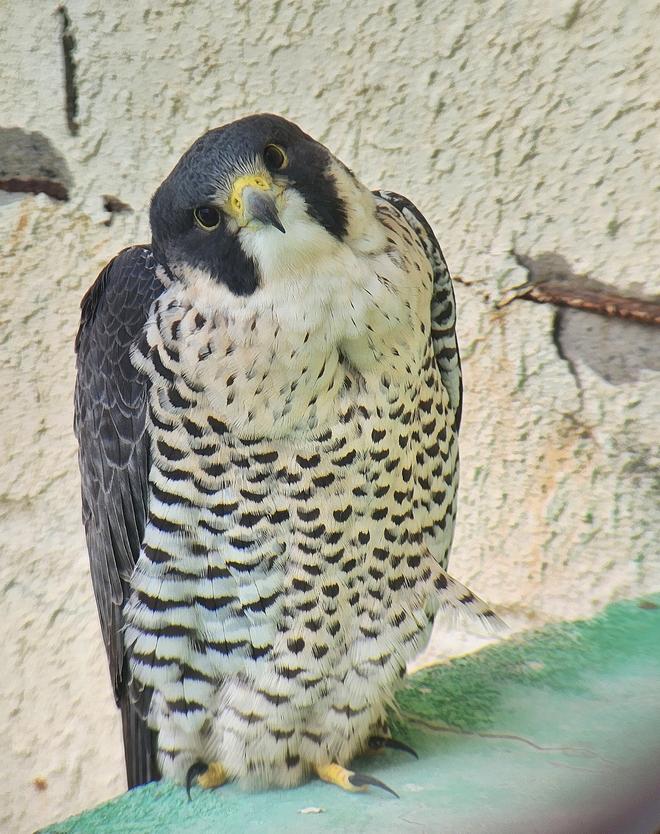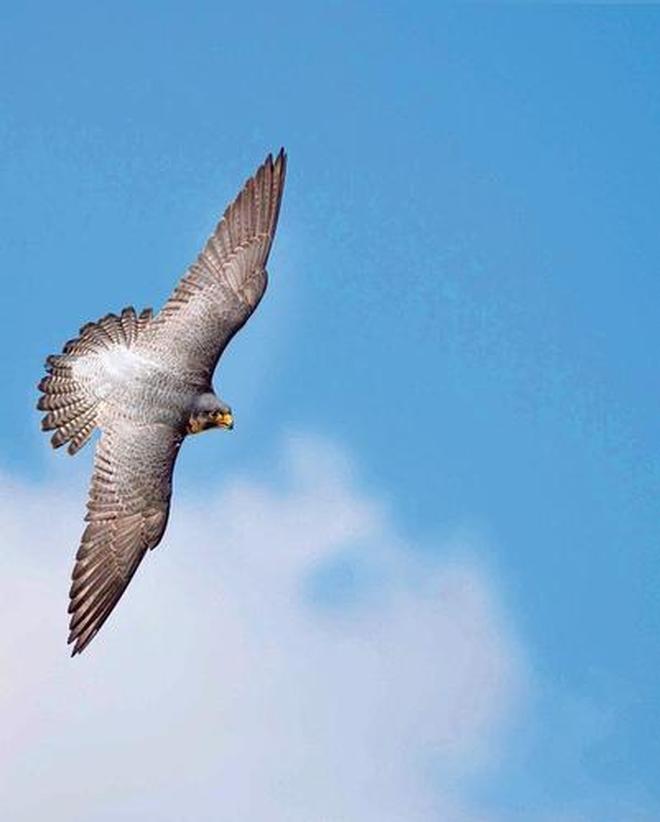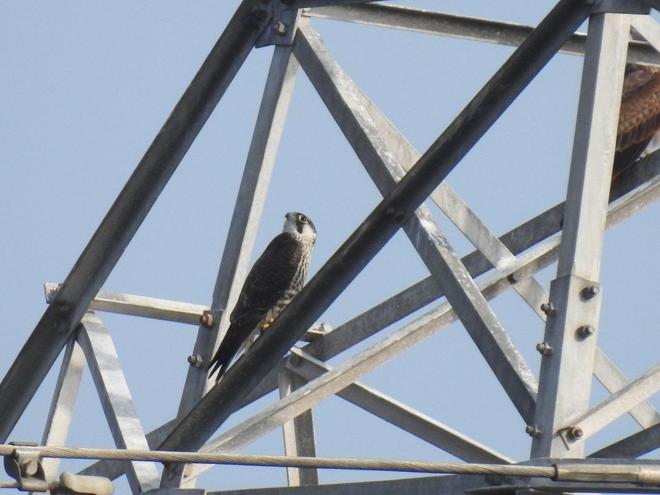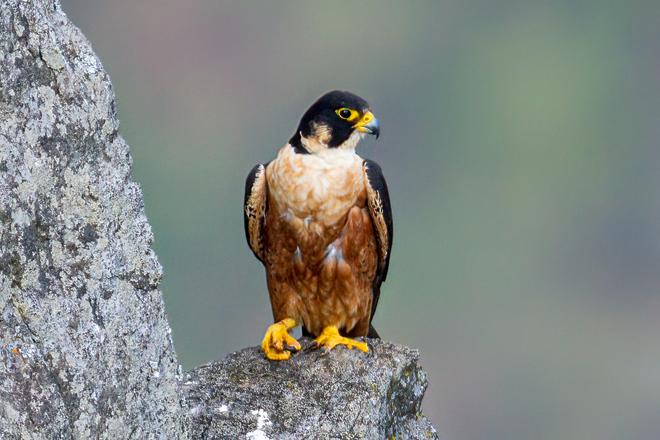Aura is perched at the edge of an overhang 29 dizzying storeys above ground, like a Marvel superhero. Overlooking a dominion of wetland hemmed in by the city and a road rolling southwest, threatening more development. She drowsily scratches her chin, eyes closed to the burgeoning March sun. Aura is a female peregrine falcon (Falco peregrinus calidus). Her distinctive dark hood, white cheek patches and slate blue back contrasts with a light underbelly marked with horizontal bars and arrowheads. A faint peach fades over her shoulders and breast.

I am here with members of the raptor study group of the Madras Naturalist’s Society. The MNS has been tracking peregrines in Chennai for almost two years, one of the first such studies in India. The study has revealed >35 individuals in the city; including a few shaheens during the southwest monsoon months. Shaheens (Falco peregrinus peregrinator) are a smaller, brighter plumaged sub-species resident in India that makes local movements. Unlike Aura, whose breeding grounds are far north, somewhere between the Eurasian Tundra and eastern Siberia.
Dozing on another precipitous ledge to our right is a tiercel (male, smaller as is typical of bird hunting raptors), Minion. He is occasionally woken from his trance by some feral rock pigeons, irreverently cavorting a few feet from him. They may share a penthouse today, but peregrines and rock pigeons evolved together on their traditional homesteads — steep crags and cliffs. Both are designed for speed; bulky bodies and deep, muscular chests powered by pointed pinions and shortish tails. Pitted against prey with a specific skill set, peregrines evolved to kill birds in rapid flight mid-air.

Successful conservation
They hunt from high perches or soaring at great heights. Once a target is locked, they simply fall out of the sky. Wings folded back in a searing nosedive (“stoop”) to smite their prey with giant clenched talons as they whoosh past. Most birds are stunned or killed on impact, with the peregrine zooming back up to grasp the dropping bird. If they miss, the falcon will give chase in horizontal pursuit where zigzagging pigeons, plovers and swifts are more evenly matched in terms of sheer speed. Peregrines have been recorded performing stoops at an eye-watering 389 kmph!

Peregrines are symbols of both successful conservation efforts and sheer adaptability. By the late 1970s, they were in precipitous decline worldwide, with many local populations going extinct; decimated by overuse of pesticides like DDT that weakened their eggshells. Phasing out of DDT and painstaking breeding programmes pulled them back from the brink. When populations slowly recovered, a new trend was observed in the 1990s. Peregrines began moving into cities.
Where do living beings thrive? Wherever there is abundant food and safe shelter. The peregrines simply sought out places that were the best approximations of their natural cliff habitats: skyscrapers and apartments with ledges and overhangs, tall bridges and spires, and electrical pylons. Not just as vantage points but as nesting sites.
A survey by the British Trust for Ornithology in 2014, covering 1,769 breeding pairs in the UK, found that urban peregrines were doing better than in their traditional homes. With cities getting better lit, some peregrines became partially nocturnal, targeting flocks migrating at night. From personal experience, most prefer west facing high-rises with shady ledges at least 15 to 16 floors high. Many choose pylons, especially near wetlands. Like the dark tiercel I saw last week, streaking after a flickering flock of plovers at Kelambakkam.

Breeding pairs and pigeon hunters
This movement also coincided with exploding feral pigeon populations. In India, their numbers went up by 150% in the last two decades, consequent to cities growing taller, astrology fuelled feeding and loss of green spaces. Some of the pigeons’ other predators, like the shikra which depends on tree cover, suddenly became less relevant.
Pigeons negatively affect local biodiversity by depressing the numbers of birds such as sparrows and mynahs (by sheer numbers and direct competition for food sources), and even food plants (they tend to attack saplings and grains). Worse still, they carry the threat of disease — there is an increasing trend of hypersensitive pneumonia among people overly exposed to pigeons. Making the presence of urban peregrines important; at places, pigeons form 80% of their diet.

What also helped is that people took kindly to having this charismatic hunter as a nesting neighbour. London has 30 breeding pairs, some with a live telecast of the nest! Shaheens have sporadically been reported nesting in Mumbai, our tallest city. But relatively little is known of peregrine numbers, movements and habits in Indian cities.
In Delhi, a handful of birds are known to frequent the same high-rises annually. But most other sightings are from wetlands and individuals are not tracked. What about the jungle of vertigo inducing high-rises spawning across the NCR? This is where dedicated and technically grounded citizen science programmes like the MNS come in, bridging the divide between the wild and us. Long may the peregrines rule our lonely, concrete sky islands.
The second in a series that looks at urban spaces as havens for biodiversity and often overlooked species.
The author is a birder and writer based in Chennai.







